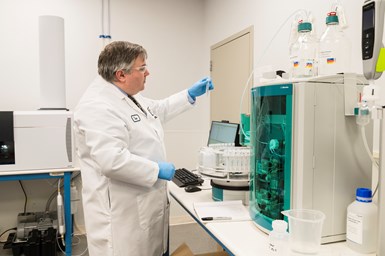Replacing Discontinued Vapor Degreasing Fluids – 3 Things to Consider
What do you do when you learn your trusted line of vapor degreasing cleaning fluids will soon be discontinued? Elizabeth Norwood of MicroCare discusses what you should keep in mind when replacing discontinued vapor degreasing fluids.

Manufacturers should choose a supplier that understands the dynamics between cleaning chemistry and cleaning equipment and has a laboratory support structure to support a smooth transition.
Photo Credit: MicroCare
Q: My vapor degreasing fluid is being discontinued. What should I do?
A: When a manufacturer learns that their trusted line of vapor degreasing cleaning fluids will soon be discontinued, they may be left wondering how to move forward. There are many factors to consider when choosing a replacement cleaning fluid, including the equipment and substrate being cleaned, the type of contamination being removed, the long-term availability of the chosen fluid, and the level of support available from the supplier. Here are the three important factors to consider when replacing discontinued vapor degreasing fluids.
1: Consider your equipment, substrate and contamination
When looking for a replacement cleaning fluid, manufacturers should first identify the type of equipment, substrate and contamination they are dealing with. This will help them narrow down their options and find a cleaning fluid that is tailored to their specific needs. It is also important to work with a supplier who has experience with similar equipment and substrates.
Manufacturers should ask potential suppliers questions about their cleaning fluid’s compatibility with their substrates and equipment. For example, if a manufacturer is cleaning steel parts, they should inquire about the cleaning fluid's ability to protect against corrosion. If a manufacturer is using a specific type of cleaning equipment, they should ask if the cleaning fluid is compatible or if the equipment will require upgrades or modifications.
Additionally, manufacturers should start to prepare for their transition now. This may involve testing new cleaning fluids on a small scale to ensure that they are effective and do not cause any damage to equipment or substrates. It may also involve training employees on how to use the new cleaning fluid and making adjustments to the cleaning process to ensure optimal performance.
2: Know the long-term availability of your chosen replacement fluid
When selecting a replacement cleaning fluid, manufacturers should choose a fluid with a proven track record and a long-term sustainability profile. This means choosing a fluid that has been on the market for a significant amount of time and has a proven record of effectiveness. Manufacturers should also consider the long-term availability of the chosen fluid. If a fluid is only available for a limited time, it may be difficult to find a replacement when it is needed.
Manufacturers should also consider the environmental impact of the chosen fluid. Many newer cleaning fluids are designed to be more environmentally friendly than older ones. This may include fluids that have a low global warming potential, or are free of hazardous air pollutants. Choosing an environmentally friendly cleaning fluid may not only benefit the environment, but also the health and safety of employees who work with the fluid.
3: Determine what support you’ll get for the replacement cleaning fluid after you buy
Finally, manufacturers should choose a supplier that understands the dynamics between cleaning chemistry and cleaning equipment and has a laboratory support structure to support a smooth transition. This means choosing a supplier that offers technical support, troubleshooting and training on the new cleaning fluid. Manufacturers should also choose a supplier that has a long-standing, good reputation for customer service and is available to answer any questions or concerns that might arise.
In conclusion, replacing discontinued vapor degreasing fluids can be a daunting task. However, by considering the equipment, substrate and contamination being cleaned, the long-term availability of the chosen fluid, and the level of support available from the supplier, manufacturers can select a replacement cleaning fluid that provides optimal cleaning performance with the least impact on the environment and their cleaning processes.
About the Author

Elizabeth Norwood
Elizabeth Norwood is a Senior Chemist at MicroCare, LLC, which offers precision cleaning solutions. She has been in the industry for more than 25 years and holds a BS in Chemistry from the University of St. Joseph. Norwood researches, develops and tests cleaning-related products. She currently has one patent issued and two pending for her work. For more information, visit www.microcare.com.
Related Content
How to Address Declining Powder Coating Coverage Over Time
Fine particles from reclaim could be to blame for powder coating problems that emerge over time. Avoid problems by keeping hooks clean, maintaining guns and using reclaim powder quickly to avoid accumulation of fines.
Read More10 Anodizing Best Practices
Following this list of guidelines can help to increase the performance, cost effectiveness and quality for your anodizing operation.
Read MoreMasking Solutions for Medical Applications
According to Custom Fabricating and Supplies, a cleanroom is ideal for converting, die cutting, laminating, slitting, packaging and assembly of medical-grade products.
Read More3 Tests to Ensure Parts are Clean Prior to Plating
Making sure that all of the pre-processing fluids are removed prior to plating is not as simple as it seems. Rich Held of Haviland Products outlines three tests that can help verify that your parts are clean.
Read MoreRead Next
Episode 45: An Interview with Chandler Mancuso, MacDermid Envio Solutions
Chandler Mancuso, technical director with MacDermid Envio discusses updating your wastewater treatment system and implementing materials recycling solutions to increase efficiencies, control costs and reduce environmental impact.
Read MoreEducation Bringing Cleaning to Machining
Debuting new speakers and cleaning technology content during this half-day workshop co-located with IMTS 2024.
Read MoreA ‘Clean’ Agenda Offers Unique Presentations in Chicago
The 2024 Parts Cleaning Conference, co-located with the International Manufacturing Technology Show, includes presentations by several speakers who are new to the conference and topics that have not been covered in past editions of this event.
Read More





















